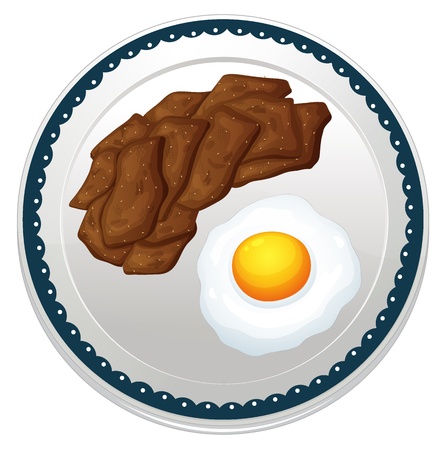Campfire Cooking Basics
Theres nothing quite like waking up to the smell of sizzling breakfast in the great outdoors. Whether youre deep in the woods or at a cozy campsite, cooking a hearty morning meal over a campfire or portable stove is one of the best parts of camping. And with one-pan skillet recipes, it’s easier than ever to whip up something delicious with minimal cleanup. But before you start cracking eggs and frying bacon, let’s go over some basics to make sure your campfire breakfast experience is both safe and successful.
Essential Tools for One-Pan Campfire Cooking
You don’t need a full kitchen setup to cook outdoors—just a few key items can get the job done. Here’s what you’ll want to pack:
| Tool | Why You Need It |
|---|---|
| Cast Iron Skillet | Holds heat well and cooks evenly; perfect for campfires. |
| Long-Handled Tongs or Spatula | Keeps your hands safe from open flames while flipping food. |
| Heat-Resistant Gloves | Protects your hands when handling hot cookware. |
| Portable Stove (optional) | A great backup if fires aren’t allowed or weather doesn’t cooperate. |
| Cooking Oil or Spray | Keeps food from sticking and makes cleanup easier. |
| Lighter or Waterproof Matches | Essential for getting your fire going quickly. |
Safety Tips for Campfire Cooking
- Always check local fire regulations before starting a campfire. Some parks have restrictions during dry seasons.
- Set up your cooking station on level ground away from tents and flammable materials.
- Keep a bucket of water or sand nearby in case of emergencies.
- Never leave your fire unattended while cooking.
- Extinguish all flames completely after youre done.
How to Prep Your Fire for Even Skillet Cooking
If you’re cooking directly over a campfire, you’ll want to avoid placing your skillet over high, flickering flames. The goal is steady, even heat—just like turning your stove burner to medium-low at home. Follow these steps:
- Build a small fire: Use dry wood and kindling to start a controlled flame. Let it burn down until you have glowing embers—not large flames.
- Create a coal bed: Spread out the hot coals into an even layer. This gives you consistent heat without burning your food.
- Position your skillet: Place your pan either on a grill grate over the coals or directly on rocks surrounding the fire pit if they’re stable and heat-safe.
- Add oil before heating: A little oil helps protect your pan and keeps ingredients from sticking as it heats up.
The Portable Stove Option
If open fires aren’t allowed—or if you prefer more control—portable propane stoves are a fantastic alternative. They provide adjustable heat levels and work great with cast iron skillets. Just remember to bring enough fuel canisters and always set up on a stable, non-flammable surface.
Quick Tip:
A windscreen can really help maintain even heat when using a portable stove outdoors. It also saves fuel!
Now that youve got the basics down, youre ready to dive into some tasty one-pan breakfast recipes that are perfect for the campsite!
2. Gear Up: Selecting the Right Skillet
When it comes to one-pan campfire breakfasts, your skillet is the star of the show. The right skillet can make your morning meal easy, delicious, and hassle-free. But not all skillets are created equal—especially when youre cooking over an open flame in the great outdoors. Lets break down the two most popular choices: cast iron and nonstick.
Cast Iron vs. Nonstick: Which One Should You Choose?
Each skillet type has its pros and cons when it comes to outdoor cooking. Heres a quick comparison to help you decide which is best for your camping style:
| Feature | Cast Iron | Nonstick |
|---|---|---|
| Heat Retention | Excellent – holds heat evenly | Good – heats quickly but cools faster |
| Durability | Extremely durable, lasts generations | Less durable, coating can scratch or wear off |
| Maintenance | Needs seasoning and care to prevent rust | Easy to clean, low maintenance |
| Weight | Heavy – may not be ideal for backpacking | Lightweight – great for lighter loads |
| Campfire Compatibility | Perfect for direct flame and high heat | Not suitable for direct flames or high heat |
Our Pick for Campfire Cooking: Cast Iron Skillet
If youre planning to cook over a campfire or hot coals, a cast iron skillet is hands-down the best choice. It can handle the heat, adds flavor over time, and can go straight from the fire to your picnic table. Yes, its heavier and requires some care, but its worth it for that perfect crispy bacon or golden-brown hash browns.
Caring for Your Skillet Outdoors
No matter which skillet you choose, taking good care of it while camping will keep your meals tasting great and your gear lasting longer. Here are a few tips:
- Pre-season at home: If using cast iron, season it before your trip to build a nonstick surface.
- Avoid soap: For cast iron, use hot water and a brush or scraper. Soap can strip seasoning.
- Pretreat nonstick pans: Use a small amount of oil before cooking to help protect the coating.
- Dry thoroughly: Always dry your skillet completely after washing to prevent rust (especially with cast iron).
- Packing tip: Wrap cast iron in a towel or cloth to avoid damaging other gear—and keep everything clean.
A Quick Checklist Before You Pack Your Skillet:
- [ ] Is it seasoned (for cast iron)?
- [ ] Do you have cleaning supplies (scraper/brush)?
- [ ] Did you pack oil or cooking spray?
- [ ] Is your skillet size right for your group?
- [ ] Do you have heat-safe gloves or tools?
The right skillet sets the tone for an awesome campfire breakfast. Whether you go classic with cast iron or light with nonstick, make sure its ready for adventure—just like you.
![]()
3. Make-Ahead Prep Tips
When youre waking up to the sound of birds chirping and the smell of pine trees, the last thing you want is to spend your peaceful morning chopping veggies or cracking eggs. With a little prep work at home, your campfire breakfasts can go from pan to plate in minutes—with less mess and more time to enjoy the outdoors.
Chop and Store Ingredients in Advance
Before heading out, dice onions, bell peppers, mushrooms, and any other veggies youll be using. Store them in reusable containers or zip-top bags labeled for each recipe. This not only saves time but also keeps your cooler organized.
Suggested Veggie Prep Chart:
| Ingredient | Prep Method | Storage Tip |
|---|---|---|
| Onions | Diced | Store in airtight container with paper towel to absorb moisture |
| Bell Peppers | Sliced or diced | Keep different colors separate to avoid soggy textures |
| Mushrooms | Sliced | Use paper bag or breathable container to prevent sliminess |
Pre-Mix Your Eggs
Crack and whisk your eggs at home, then pour them into a sealed bottle or jar. Add a dash of milk or seasoning if desired. This way, you can just shake and pour straight into your skillet when youre ready to cook.
Pre-Cook Meats Where Possible
If youre planning on adding sausage, bacon, or ham to your skillet breakfast, consider pre-cooking these at home. It cuts down on cook time and reduces grease splatter at the campsite.
Pro Tip:
Wrap pre-cooked meats in foil packets so they’re easy to warm over the fire without dirtying another pan.
Portion Out Dry Ingredients
If your breakfast includes pancake mix, biscuit dough, or oats, measure and pack dry ingredients into individual servings before leaving. Label each bag with instructions like “Add 1 cup water” so there’s no guesswork early in the morning.
Pack Smart for Easy Access
Group all breakfast ingredients together in one section of your cooler or camp kitchen tote. Use stackable containers to save space and keep frequently used items like oil spray, salt, and butter within arm’s reach.
Quick Grab-and-Go Checklist:
- Pre-chopped veggies
- Bottled eggs (pre-whisked)
- Pre-cooked meats in foil packets
- Labeled dry mixes (for pancakes or biscuits)
- Toppings like shredded cheese or green onions in small containers
A little prep at home goes a long way toward making your one-pan campfire breakfasts stress-free and delicious. Youll thank yourself when all thats left is flipping eggs and sipping coffee by the fire.
4. Savory Skillet Favorites
If youre looking for a filling way to kick off your morning in the great outdoors, savory one-pan breakfasts are the way to go. These hearty meals are packed with protein and flavor, and they’re super easy to make over a campfire or portable stove. Here are a few crowd-pleasing skillet recipes that’ll keep you fueled up for a day of hiking, fishing, or just relaxing at the campsite.
Campfire Hash
This classic camping dish is all about simple ingredients that cook up fast and taste amazing together. Toss diced potatoes, onions, bell peppers, and your choice of breakfast meat—like sausage or bacon—into your cast iron skillet. Cook until golden and crispy, then crack a few eggs on top and cover until the eggs are cooked to your liking.
Ingredients:
| Item | Amount |
|---|---|
| Diced potatoes | 2 cups |
| Chopped onions | 1/2 cup |
| Bell peppers (diced) | 1/2 cup |
| Sausage or bacon | 1/2 lb |
| Eggs | 2-4 |
Breakfast Burrito Scramble
This one-skillet wonder gives you all the flavors of a breakfast burrito without needing to roll anything up. Scramble eggs with cooked chorizo or sausage, shredded cheese, black beans, and chopped veggies like tomatoes or green onions. Serve it straight from the pan or scoop into tortillas if youre craving that handheld bite.
Quick Tip:
Pre-chop your veggies and store them in zip-top bags before your trip to make mornings even easier.
Sausage Veggie Medley
This colorful skillet mix is both delicious and nutritious. Slice up some smoked sausage links and sauté them with zucchini, cherry tomatoes, mushrooms, and red onion. Season with salt, pepper, and a little garlic powder for an easy, no-fuss breakfast that’s packed with flavor.
Best Pairing:
Enjoy this medley with a slice of toasted bread or next to some scrambled eggs for extra protein.
Savory skillet breakfasts like these are perfect for campers who love bold flavors and easy cleanup. With just one pan and a handful of ingredients, you can whip up a satisfying morning meal thatll power you through whatever adventures lie ahead.
5. Sweet Mornings Around the Fire
There’s nothing like starting your day in the great outdoors with a warm, sweet breakfast straight from the skillet. Whether you’re camping with family or friends, a little morning sugar can go a long way to boost morale and bring smiles around the campfire. These one-pan sweet breakfasts are simple to make, easy to clean up, and packed with flavor.
Cinnamon Apple Skillet Pancakes
These fluffy pancakes are filled with warm cinnamon-spiced apples and cooked right in your cast iron skillet over the fire. The apples caramelize slightly, giving each bite a comforting, fall-inspired flavor—perfect for crisp mountain mornings.
Ingredients:
- 1 apple, thinly sliced
- 1 tsp cinnamon
- 2 tbsp brown sugar
- Pancake mix (your favorite brand or homemade)
- Butter or oil for the pan
Quick Instructions:
- Sauté apples, cinnamon, and brown sugar in butter until soft.
- Pour pancake batter over the apples and cook until bubbles form on top.
- Flip carefully and cook through. Serve warm with maple syrup.
Bananas Foster Oatmeal Skillet
This spin on classic oatmeal adds flair to your breakfast routine. Sliced bananas caramelized in brown sugar and butter bring out rich flavors that pair perfectly with hearty oats.
| Ingredient | Amount |
|---|---|
| Old-fashioned oats | 1 cup |
| Sliced ripe bananas | 2 |
| Brown sugar | 2 tbsp |
| Butter | 2 tbsp |
| Cinnamon (optional) | ½ tsp |
| Water or milk | 2 cups |
Campfire Tip:
You can prep the dry ingredients at home in zip bags and just add water or milk at camp!
Campfire French Toast Skillet Bake
This rustic take on French toast is made by layering thick bread slices soaked in an egg-milk mixture into your skillet. Add toppings like berries, powdered sugar, or even marshmallows for a fun twist.
You’ll Need:
- Bread slices (brioche or Texas toast work great)
- Eggs – 3 to 4 depending on portion size
- Milk – about 1 cup
- Cinnamon & vanilla extract for extra flavor
- Toppings: berries, syrup, powdered sugar, nuts
How To Make It:
- Whisk eggs, milk, cinnamon, and vanilla together.
- Dunk bread slices into mixture and layer them in a greased skillet.
- Cook covered over low heat until set and golden brown on bottom.
- Add toppings before serving warm off the fire.
No matter which recipe you try, these one-pan sweet breakfasts are sure to make your mornings around the fire unforgettable—and delicious!
6. Cleanup and Leftover Hacks
After a hearty one-pan breakfast at the campsite, the last thing you want is to spend a ton of time scrubbing dishes—especially without running water. Luckily, with a few smart hacks, cleanup can be fast and easy. Plus, those leftover scrambled eggs or sausage bits? They don’t have to go to waste. Let’s break it down.
Smart Tips for Quick Cleanup Without Running Water
1. Use Parchment Paper or Foil Liners
Before cooking, line your skillet with parchment paper or heavy-duty aluminum foil. This prevents food from sticking and makes cleanup as simple as tossing the liner into your trash bag.
2. Wipe First, Wash Later
Use a paper towel or old rag to wipe out as much grease and food residue as possible right after cooking. This helps prevent buildup and makes washing easier when you get back to camp or home.
3. Bring a DIY Wash Kit
Create a compact wash kit that includes:
- Biodegradable soap
- A small sponge or scrub pad
- A collapsible basin or large resealable bag for soaking
- Microfiber towel for drying
4. Heat Water Over the Fire
If you need warm water for tough messes, heat some in your skillet after wiping it out. Just be sure to let it cool before cleaning.
Creative Ways to Use Breakfast Leftovers
No one likes wasted food on the trail. Turn your leftovers into easy lunches or snacks for later in the day.
Leftover Ideas Table
| Breakfast Leftover | Turn It Into… | How-To Tip |
|---|---|---|
| Scrambled Eggs & Veggies | Wraps or Burritos | Toss into a tortilla with hot sauce and cheese for an on-the-go lunch. |
| Sausage Bits or Bacon Crumbles | Trail Mix Add-In | Add cooled meat pieces to nuts and dried fruit for a savory snack blend. |
| Pancakes or Biscuits | Mini Sandwiches | Slice them open and stuff with peanut butter, jam, or leftover meats. |
| Hash Browns or Potatoes | Crispy Trail Tots | Sauté with spices over the fire later for a crunchy afternoon snack. |
Pro Tip:
If youre not eating leftovers within a few hours, store them in a cooler with plenty of ice packs to keep things safe and fresh until youre ready to repurpose them.
With just a little planning, both cleanup and leftovers become part of the fun—not the hassle—of cooking outdoors.


